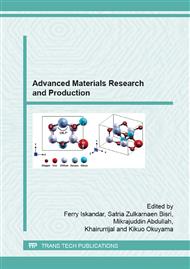p.275
p.279
p.282
p.286
p.290
p.294
p.299
p.303
p.308
Synthesis of Reduced Graphene Oxide (rGO)/Ni Composite by a Combination of Marcano’s and Microwave Assisted Reduction Methods
Abstract:
A reduced graphene oxide/nickel (rGO/Ni) composite has been succesfully synthesized using a combination of Marcano’s method for synthesizing graphene oxide (GO), subsequently followed by a facile microwave assisted reduction method. X-ray diffraction results show the presence of graphene and nickel on the prepared samples. In addition, the Fourier Tansform Infrared Spectroscopy measurement showed that the absorption peaks of O-H, C=O, C-OH, and C-O only appear in the GO sample. A Scanning Electron Microscope photograph shows that the morphology of the rGO samples contain nano-layered forms. A Raman spectroscopy characterization of the prepared rGO samples show a peak of G band’s wave number at 1586.5 cm-1. From the calculation of the G band’s wave number, the average number of graphene layers is 1.15.
Info:
Periodical:
Pages:
290-293
Citation:
Online since:
July 2015
Authors:
Keywords:
Price:
Сopyright:
© 2015 Trans Tech Publications Ltd. All Rights Reserved
Share:
Citation:


